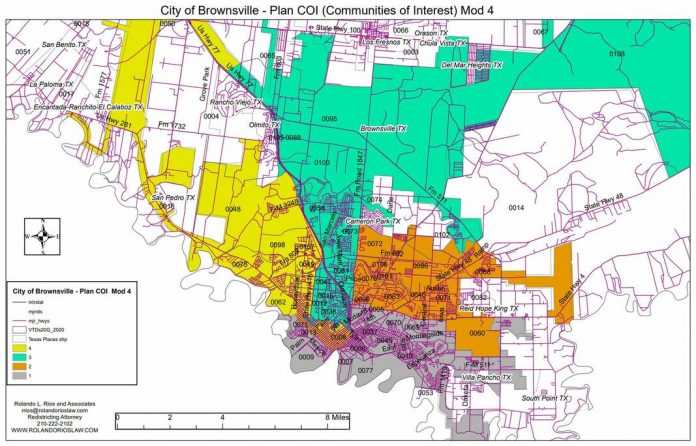By GARY LONG
Staff Writer
Due to population changes revealed by the 2020 Census, the City of Brownsville is required under the Constitution to redraw boundary lines for its four City Commission districts to equalize the population in each, maintain communities of interest and other factors.
The City Commission has been working with law offices of redistricting attorney Rolando L. Rios, who has helped Brownsville redistrict after previous census counts.
At a City Commission workshop Oct. 16 Rios said Article 1 Section 2 of the U.S. Constitution requires Brownsville, as well as governments large and small all across the country, to redistrict. This will be the 24th redistricting since the founding of the republic in 1776.
Rules for drawing districts include to equally populate within a 10% deviation between highest and lowest populated district using census data, not dilute voting strength of racial minorities, keep incumbents in their respective districts to the extent possible, keep the districts compact and contiguous, and maintain communities of interest, Rios told the commission.
“I applied the census data to your existing districts. The results were District 3 is the fastest growing. It has over 60,000 people. District 1 was the slowest growing at 32,000, your top to bottom deviation is 60% so you will have to redistrict,” Rios said.
Rios noted that the has helped redistrict Brownsville, Harlingen, Weslaco and McAllen in the Rio Grande Valley, San Antonio, Austin, Dallas and Houston, among other,s after past census counts.
“Total population in Brownsville is 186,738, you divide that by four and that is your ideal district, 46,685,” he said. “The application of the census data show that your high, which is District 3, is 60,362. Your lowest is District 1, which is 32,163. You subtract those two numbers and you get a difference of 28,199 which is a 60.4 deviation, so you will have to redistrict, and I’ve been working with some of you on drawing up some various iterations,” he said.
Rios presented several possible maps of the four districts, all of which would meet constitutional muster, but said he recommended iteration 4. Mayor Trey Mendez said he agreed with Rios’ recommendation, as did city commissioners from several districts.
As Rios discussed the proposed map, he pointed out that District 3, which is where most of Brownsville’s current growth has occurred, will have the most room to grow after redistricting.
City Commissioner Nurith Galonsky, who represents the Southmost area as the District 1 commissioner, has posted information on her Facebook page about the redistricting effort, including a composite recommended map and breakouts for each of the four districts.
“District 1, which I represent, is currently the smallest district in Brownsville and has to grow by about 14,500 people (the idea being that the City’s population should be more or less equally divided into the four districts that we have),” she says in the post.
In an interview, Galonsky said the city plans to have a public hearing on the matter at it its meeting Tuesday at City Hall, 1000 Elizabeth St.
“At some point we do have to engage the public so that they can give us their input,” she said. “As we know most of the growth for the city has gone up north, especially north of FM 802 and so that’s why District 3 currently has a much larger population than District 1. District 1 and District 2 are the ones that have to grow and then District 3 and 4 have to shed a bit of their population but for the most part District 2 and District 4 are less affected,” she said.
“So what the redistricting attorney informed us is the drastic difference between District 3 and District 1, that’s what made it unconstitutional and so we have to redistrict to more evenly distribute the city’s population into the four districts, because the difference between the largest and the smallest district has to be less than 10%.” she said.
“We have to get everything resolved before the end of the year, and so considering that we’re almost to November I’m assuming that these public hearings are going to have to happen really soon.”
Galonsky also urged people to get involved.
“In general we need people to be more engaged, to be more aware of what’s happening,” she said. “Facebook is a good way to get information to people, but even then they sometimes don’t understand. …If they really do have a concern about things, then please participate in the public hearings. My biggest concern with the redistricting is that there’s not a lot of representation right now at the City Commission for people that live on the east side of Brownsville. Currently it’s just Commissioner (Jessica) Tetreau and I. So that’s why I wanted to make sure that however District 1 expanded it did not dilute the voice of the people I currently represent because a lot of people live on the north side and a lot of people live on the west side. … I don’t know if people will actually participate, but we need to give them the opportunity to have their voices heard.”





